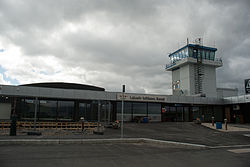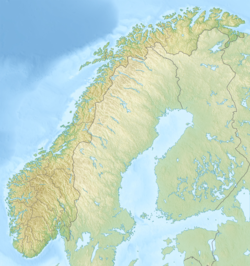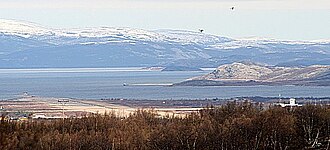
Trondheim Airport, Værnes is an international airport serving Trondheim, a city and municipality in Trøndelag county, Norway. The airport is located in Værnes, a village in the municipality of Stjørdal in Trøndelag county, 10 nautical miles east of Trondheim. Operated by the state-owned Avinor, it shares facilities with Værnes Air Station of the Royal Norwegian Air Force. In 2018, the airport had 4,441,870 passengers and 58,273 air movements, making it the fourth-busiest in the country. The airport has two terminals; A dates from 1994 and is used for domestic traffic, while B is the renovated former main terminal from 1982, and is used for international traffic. The airport features a main east–west 2,999-metre (9,839 ft) runway, a disused northwest–southeast 1,472-metre (4,829 ft) runway, an integrated railway station and an airport hotel.
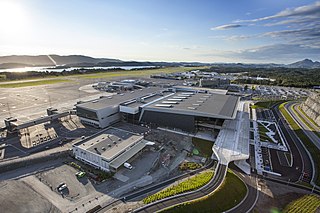
Bergen Airport, Flesland, alternatively Bergen Flesland Airport or simply Flesland Airport, is an international airport located at Flesland in the city and municipality of Bergen, Vestland, Norway. Opened in 1955, it is the second-busiest airport in Norway, with 6,306,623 passengers in 2018. Flesland is operated by the state-owned Avinor. Until 1999 Flesland Air Station of the Norwegian Air Force was co-located at the airport.
Andøya Airport, Andenes is a domestic airport located in the village of Andenes in Andøy Municipality in Nordland county, Norway. It is situated on the northern tip of the island of Andøya. The airport is the civilian sector of Andøya Air Station and is operated by the state-owned Avinor. The airport consists of two runways, 2,468 and 1,672 meters long, and served 48,254 passengers in 2012. Widerøe operates public service obligation (PSO) flights to Bodø, Tromsø, Stokmarknes and Harstad/Narvik, while Norwegian Air Shuttle operates seasonal flights to Oslo.

Harstad-Narvik Airport, Evenes is an international airport located in Evenes Municipality in Nordland county, Norway. The airport serves the towns of Harstad and Narvik. It is co-located with Evenes Air Station of the Royal Norwegian Air Force. The civilian sector is owned and operated by the state-owned Avinor and handled 654,977 passengers in 2013. Evenes has a 2,808-meter (9,213 ft) runway, a parallel taxiway and a terminal with five gates. The airlines with daily scheduled services are Norwegian Air Shuttle, Scandinavian Airlines (SAS) and Widerøe. Destinations with daily services are Oslo, Trondheim, Bodø, Tromsø and Andenes. Evenes is the only primary airport in Central Hålogaland and its catchment area for Oslo-bound flights includes Lofoten and Vesterålen.

Tromsø Airport, Langnes is an international airport located at Langnes in the city of Tromsø in Tromsø Municipality, Troms og Finnmark county, Norway. Situated on the western shore of the island of Tromsøya, it features a 2,447-meter (8,028 ft) runway aligned 01/19. Owned and operated by the state-owned Avinor, Langnes handled 1,910,692 passengers, 43,219 aircraft movements and 2,758 tonnes of cargo in 2014. This makes Tromsø the fifth-busiest airport in the country.

Alta Airport is an international airport serving Alta, a town and municipality in Troms og Finnmark county, Norway. The airport is located at Elvebakken, 4 kilometers (2.5 mi) east of the city center. It has a single, 2,253-meter (7,392 ft) runway numbered 11/29, which lies on the southern shore of the Altafjord. Alta Airport is owned and operated by the state-owned Avinor, and served 368,393 passengers in 2014, making it the busiest airport in Finnmark.

Sørkjosen Airport is a regional airport located at the village of Sørkjosen in Nordreisa Municipality in Troms og Finnmark county, Norway, about 4.5 kilometres (2.8 mi) from the municipal center of Storslett. Owned and operated by the state-owned Avinor, it handled 15,198 passengers in 2014. The airport has a 880-meter (2,890 ft) runway and is served by Widerøe, which operates regional routes using the Dash 8-100 to Tromsø and communities in Finnmark on public service obligation contracts. The airport opened in 1974 and was originally served using de Havilland Canada Twin Otter aircraft. Dash 8s were introduced in 1995 and two years later ownership was transferred from Nordreisa Municipality to the state.
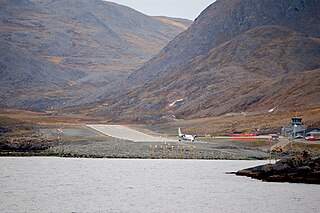
Honningsvåg Airport, Valan is a regional airport serving Honningsvåg in Nordkapp, Norway. The airport is located at Valan, on the south side of Skipsfjorden, 4 kilometers north of the town, and 31 km from the North Cape. The airport has a 880-by-30-meter asphalt runway which is operated by the state-owned Avinor. Flights are operated by Widerøe to Tromsø with connecting flights to Oslo. The airline also fly to other communities within Finnmark, who serve the airport with Dash 8-100 and Q200 aircraft. The airport handled 13,487 passengers in 2014.
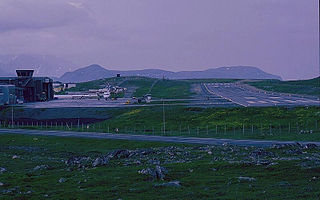
Hammerfest Airport is a regional airport at Prærien in Hammerfest, Norway. It is operated by the state-owned Avinor and handled 145,396 passengers in 2014, making it the third-busiest regional airport in the country. The airport has a 880-meter (2,890 ft) runway aligned 05/23. Services are provided by Widerøe using the Dash 8-100. Up to eight daily flights are provided to Tromsø and public service obligation flights are flown eastwards to other airports in Finnmark. The airport is the base for offshore helicopter services operated by Bristow Norway and CHC Helikopter Service. An estimated 40,000 people from Hammerfest Airport's catchment area annually use Alta Airport for flights to Oslo.

Båtsfjord Airport is a regional airport serving Båtsfjord in Troms og Finnmark, Norway. It consists of a 1,000 by 30 meters runway and served 14,485 passengers in 2016. A further 14,663 landed and started at the airport without leaving the aircraft. Scheduled services are provided by Widerøe using the Dash 8 to Kirkenes, Hammerfest and other communities in Finnmark. The airport is owned and operated by the state-owned Avinor.

SAS Commuter, also branded as Scandinavian Commuter, was a regional airline which operated in Denmark, Norway and Sweden. A sister company of Scandinavian Airlines (SAS), it operated various regional services on behalf of the Scandinavian flag carrier. The airline was headquartered at Copenhagen Airport, which also served as its main base. It later also operated bases at Tromsø Airport; Stockholm Arlanda Airport; Trondheim Airport, Værnes and Bergen Airport, Flesland.
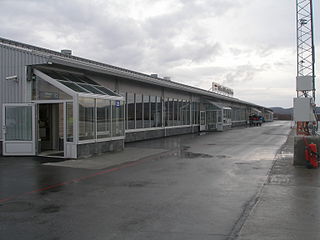
Kirkenes Airport, Høybuktmoen is an international airport located at Høybuktmoen, 15 kilometers (9 mi) west of the town of Kirkenes, in the municipality of Sør-Varanger, Troms og Finnmark county, Norway. Operated by the state-owned Avinor, the airport has a single 2,115-by-45-meter asphalt runway numbered 05-23. Scandinavian Airlines and Norwegian Air Shuttle operate Boeing 737-services to Oslo Airport, Gardermoen, in part generated by Høybuktmoen's function as a hub for Widerøe's regional services to other airports in eastern Finnmark. There are also summer charter flights to Central Europe to bring tourists to the Hurtigruten cruises. The airport had 297,149 passengers in 2013.

Bardufoss Airport is a primary airport situated at Bardufoss in Målselv Municipality in Troms og Finnmark county, Norway. The airport, which is the civilian sector of the Royal Norwegian Air Force's (RNoAF) Bardufoss Air Station, is operated by the state-owned Avinor. It consists of a 2,443-meter (8,015 ft) runway, a parallel taxiway and handled 218,451 passengers in 2014. Scandinavian Airlines (SAS) operates three daily flights with Boeing 737s to Oslo. The airport's catchment area covers central Troms.

Station Group Banak, formerly Banak Air Station, is a military airbase located at Banak, just north of Lakselv in Porsanger in Troms og Finnmark, Norway. Operated by the Royal Norwegian Air Force (RNoAF), it serves a detachment of the 330 Squadron, which operates two Westland Sea King helicopters used for search and rescue operations in Finnmark, Svalbard and surrounding Arctic sea areas. Of the station's two helicopters, one is on standby at any given time. The station group is co-located with the civilian Lakselv Airport, Banak and is administratively under the 132nd Air Wing and Bodø Main Air Station. Banak is RNoAF's most northerly base and has fifty employees.

Brønnøysund Airport, Brønnøy is a regional airport located at the town of Brønnøysund, in the municipality of Brønnøy, Nordland county, Norway. The airport is owned and operated by the state-owned Avinor and serves the southern part of Helgeland. It has a 1,200-by-30-meter runway numbered 03–21 and is served by Widerøe, which operates their Bombardier Dash 8 aircraft to Oslo, Trondheim, Bodø, Bergen and other airports in Helgeland. The airport also serves offshore helicopter flights by CHC Helikopter Service to Norne and temporary oil rigs in the Norwegian Sea. In 2014, the airport served 117,471 passengers, making it the second-busiest regional airport in Norway, after Florø Airport.

Hasvik Airport is a regional airport serving Hasvik Municipality in Troms og Finnmark county, Norway. The airport is located in the village of Hasvik on the island of Sørøya. In 2012, Hasvik Airport had 7,629 passengers, making it the third-least busy airport operated by the state-owned Avinor. The airport consists of a 909-meter (2,982 ft) runway and is served by Widerøe with Dash 8-100 aircraft.
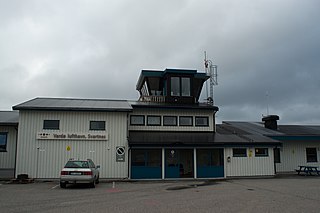
Vardø Airport, Svartnes is a short take-off and landing airport located at Svartnes in Vardø Municipality in Troms og Finnmark county, Norway. Owned and operated by the state-owned Avinor, it served 14,664 passengers in 2012. The airport has a 1,145-by-30-meter runway aligned 15–33. It is served by Widerøe who operate Bombardier Dash 8 aircraft to Kirkenes and other communities in Finnmark. The airport is located 4 kilometers (2.5 mi) from Vardøya and the town center of Vardø.

Berlevåg Airport is a regional airport serving Berlevåg Municipality in Troms og Finnmark county, Norway. The airport is situated 2 kilometers (1.2 mi) northwest of the village of Berlevåg and is owned and operated by Avinor. The airport has a 880-meter (2,890 ft) runway aligned 06/24. Services are provided by Widerøe using Dash 8-100 aircraft to other communities in Finnmark. The airport served 5,921 passengers in the terminal and received the most subsidies per passenger of any Avinor airport. A further 8,948 landed and started at the airport without leaving the aircraft.
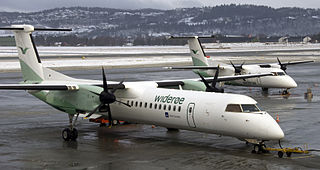
Widerøe, a regional airline based in Norway, was established by Viggo Widerøe, Einar Isdahl and Arild Widerøe on 19 February 1934. The airline started off with a combination of scheduled, aerial photography and general aviation services using seaplanes. It lost its route concessions to Norwegian Air Lines in 1935 and was subsequently bought by that company, for whom it operated several minor routes. World War II hindered Widerøe from operating any flights between 1939 and 1945. After the war Widerøe started flying various seaplane routes that were too small for DNL and its successor, Scandinavian Airlines System (SAS). These routes were commonly flown using Noorduyn Norseman and de Havilland Canada Otter aircraft. During the 1960s Widerøe attempted operating Douglas DC-3s for charter flights, but soon closed those operations.
Arctic Air AS was a Norwegian airline which operated between 1996 and 2003. From 2000 to 2003 it built up a network of scheduled services, in part based on public service obligation (PSO) contracts, flying with two Dornier 228. The company was based in Alta.
